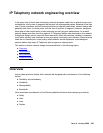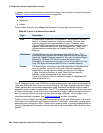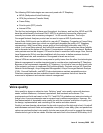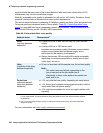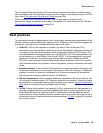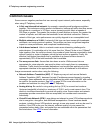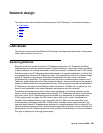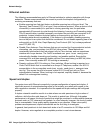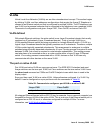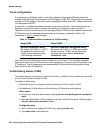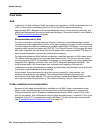
Best practices
Issue 6 January 2008 287
The Converged Network Analyzer (CNA) can help you measure and report on network delay,
jitter, and packet loss. CNA can also provide you with a rating of voice quality using the 0-5 APR
score (see C
NA Application Performance Rating on page 254).
With the optional Path Optimization feature, CNA can also help you optimize voice
performance, hence insure that voice quality is acceptable. For more information on CNA see
The Converged Network Analyzer
on page 344.
Best practices
To consistently ensure the highest quality voice, Avaya highly recommends consideration of the
following industry best practices when implementing IP Telephony. Note that these suggestions
are options, and might not fit individual business needs in all cases.
● QoS/CoS. QoS for voice packets is obtained only after a Class of Service (CoS)
mechanism tags voice packets as having priority over data packets. Networks with periods
of congestion can still provide excellent voice quality when using a QoS/CoS policy. The
recommendation for switched networks is to use IEEE 802.1p/Q. The recommendation for
routed networks is to use DiffServ Code Points (DSCP). The recommendation for mixed
networks is to use both. Port priority can also be used to enhance DiffServ and IEEE
802.1p/Q. Even networks with plentiful bandwidth should implement CoS/QoS to protect
voice communications from periods of unusual congestion, such as a computer virus might
cause.
● Switched network. A fully switched LAN network is a network that allows full duplex and
full endpoint bandwidth for every endpoint that exists on that LAN. Although IP Telephony
systems can work in a shared or hub-based LAN, Avaya recommends the consistently
high results that a switched network lends to IP Telephony.
● Network assessment. A Basic Network Readiness Assessment Offer from Avaya is vital
to a successful implementation of IP Telephony products and solutions. Contact an Avaya
representative or authorized dealer to review or certify your network. Network assessment
offer explains the options that are available with this offer.
● VLANs. Placing voice packets on a separate VLAN or subnetwork from data packets is a
generally accepted practice to reduce broadcast traffic and to reduce contention for the
same bandwidth as voice. Note that Avaya IP Telephones provide excellent broadcast
storm protection. Other benefits become available when using VLANs, but there can be a
substantial cost with initial administration and maintenance.
VLANs on page 291 explains
this concept further.







